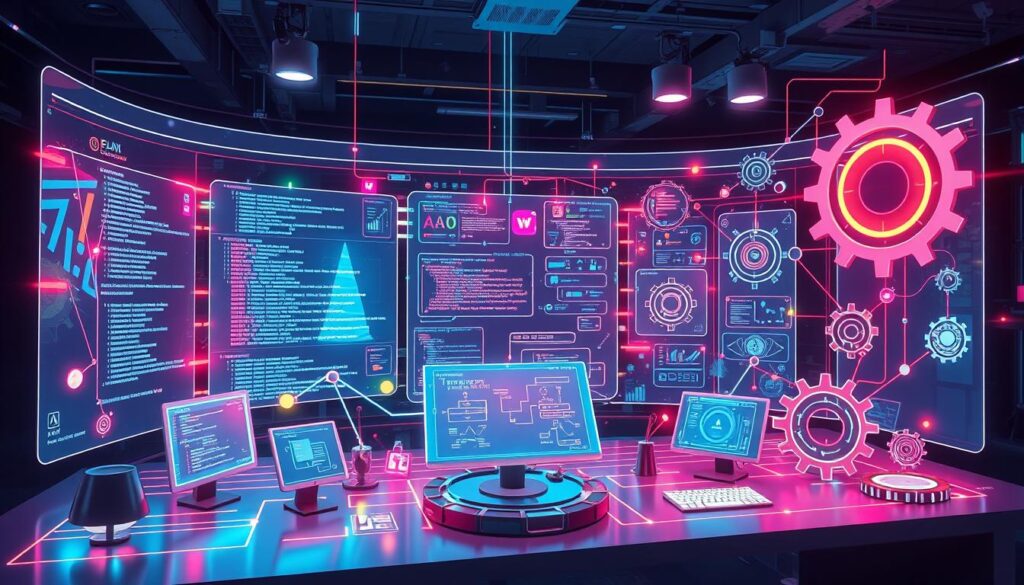How to Create an AI Agent: A Beginner’s Guide

Artificial intelligence basics are key to making AI agents. These agents are vital in AI development. Machine learning helps them learn and adapt. This guide will cover creating an AI agent, from the basics to deployment.
Knowing AI and machine learning basics is crucial for making an AI agent. This guide will give a detailed overview of the process. You’ll learn how to create and deploy an AI agent in real-world settings.
Introduction to AI Agents
AI agents are computer programs that use AI and machine learning to work on their own. They can learn and adapt to new situations. This makes them important in many fields, like healthcare, finance, and transportation. We’ll look at how to make an AI agent, including what makes them special.
Key Takeaways
- Understanding artificial intelligence basics is essential for creating an AI agent
- Machine learning plays a significant role in the development of AI agents
- AI agents have the ability to learn and adapt to new situations
- AI development is a crucial part of creating an effective AI agent
- Deploying an AI agent in a real-world setting requires careful planning and testing
- AI agents have many real-world applications, including healthcare, finance, and transportation
Understanding AI Agents: Basic Concepts and Fundamentals
To understand AI agents, knowing the AI agent definition is key. It’s a program that uses AI fundamentals to see its environment and act to reach its goals. AI agents come in different types of AI agents, each with its own traits and uses.
AI agents have traits like autonomy, reactivity, proactivity, and social ability. These traits help them interact with their world, adjust to new situations, and decide based on their goals. The AI fundamentals of making agents involve knowing how to make them see, think, and act.
There are many types of AI agents, like simple reflex agents, model-based reflex agents, and hybrid agents. Each type has its own good points and weak spots. The right agent type depends on the task and needs. Knowing the AI agent definition and the different types of AI agents helps developers make useful AI agents for many tasks.
Important AI fundamentals for making AI agents include:
- Autonomy: The ability of the agent to work on its own
- Reactivity: The ability of the agent to react to changes in its environment
- Proactivity: The ability of the agent to take the lead and reach its goals
- Social ability: The ability of the agent to talk to other agents and humans
By knowing these AI fundamentals and the different types of AI agents, developers can make effective AI agents. These agents can do many tasks and meet their goals.
Essential Prerequisites for Creating an AI Agent
To make an AI agent, you need to know the AI development prerequisites and have the right skills. You should be good at programming languages like Python, Java, or C++. It’s also important to know about data structures, algorithms, and software design patterns.
Having a clear goal for your AI agent is key. This goal should be specific, measurable, achievable, relevant, and time-bound (SMART). A well-defined goal helps make your AI agent more effective and efficient.
Some important skills and knowledge for creating an AI agent include:
- Programming skills in languages like Python, Java, or C++
- Familiarity with data structures and algorithms
- Understanding of software design patterns
- Knowledge of machine learning and deep learning concepts
With these skills and knowledge, you can create an AI agent that works well and meets your goals. It’s also crucial to keep up with the latest in AI and machine learning. This ensures your AI agent stays competitive and relevant.
Setting Up Your Development Environment
To make an AI agent, you need the right tools. This means picking the best software and tools, like IDEs and version control systems. A good AI development environment helps you work efficiently and test your AI agent well.
For AI programming, languages like Python, Java, and C++ are popular. Each has its own strengths and weaknesses. Python is often chosen for AI because it’s easy to use and has lots of libraries, like NumPy and scikit-learn.
Required Software and Tools
You also need to pick the right AI frameworks. These frameworks offer tools and functions to make development easier. TensorFlow, PyTorch, and Keras are some top choices. They help with tasks like data prep, training, and checking models.
Programming Languages for AI Development
The right AI framework depends on your project’s needs. TensorFlow is great for big deep learning projects. PyTorch is good for quick prototyping and research. Keras is a simpler way to build neural networks, working with TensorFlow or Theano.
Framework Selection Guide
| Framework | Strengths | Weaknesses |
|---|---|---|
| TensorFlow | Scalable, flexible, and widely adopted | Steep learning curve, complex architecture |
| PyTorch | Easy to use, rapid prototyping, dynamic computation graph | Less scalable than TensorFlow, limited support for parallel processing |
| Keras | High-level interface, easy to use, runs on top of TensorFlow or Theano | Less flexible than TensorFlow or PyTorch, limited support for custom layers |
Choosing the right AI tools, languages, and frameworks makes your development smoother. This way, you can build a strong and efficient AI agent.
How to Create AI Agent: Step-by-Step Process
The AI agent creation process has several key steps. First, you need to define the agent’s goals and objectives. This is the foundation of the entire process. It’s crucial because it sets the agent’s purpose and how it will function.
After setting the agent’s goals, you must design its architecture. This includes aspects like perception, action, and learning. A good architecture lets the agent interact with its environment and make smart decisions.
Defining Agent Goals and Objectives
Developers must identify the agent’s main goals and objectives. They should ask questions like: What is the agent’s purpose? What tasks should it perform? What decisions should it make? Answering these questions helps understand the agent’s role and duties.
Designing the Agent Architecture
A well-designed agent architecture is key for an effective AI agent. It involves choosing the right components, like sensors and learning algorithms. The architecture should be flexible to handle changes and new requirements.

Implementing Core Functions
Once the architecture is designed, you need to implement the core functions. This includes sensing the environment, reasoning, and acting. Writing code for these functions lets the agent interact with its environment and make decisions based on its goals.
Training Methods and Learning Algorithms
AI training methods are key for AI agents to learn from data and get better over time. Many machine learning algorithms, like decision trees and neural networks, help achieve this. Supervised learning is a common method, where the agent learns from labeled data to understand input and output.
Other methods include unsupervised learning, where the agent finds patterns in unlabeled data, and reinforcement learning, where it learns by trying and failing. Deep learning techniques also play a role in making the agent more adaptable and skilled.
- Model selection and training
- Hyperparameter tuning
- Regularization techniques
These parts are vital for the AI agent to learn well and work well with new data.
By using different AI training methods and machine learning algorithms, developers can make AI agents that learn, adapt, and get better over time. This leads to more efficient and effective decision-making systems.
Building the Agent’s Decision-Making System
The decision-making system is key for an AI agent. It lets the agent make smart choices based on what it sees and its goals. This system uses AI decision-making, which can be done in many ways.
One way is rule-based systems. These are rules that tell the agent how to act. This works well for clear problems. But, it can’t handle new situations easily. To fix this, adding machine learning helps the agent learn and change as it goes.
Key Components of the Decision-Making System
- Rule-based systems: involve creating a set of rules to govern the agent’s behavior
- Machine learning integration: enables the agent to learn from experience and adapt to new situations
- Optimization techniques: ensure the decision-making process is efficient and effective
By mixing these parts, an AI agent can make good choices in many situations. Using AI decision-making, rule-based systems, and machine learning makes the agent smart and adaptable. This makes it useful for many tasks.
| Component | Description |
|---|---|
| Rule-based systems | Involve creating a set of rules to govern the agent’s behavior |
| Machine learning integration | Enables the agent to learn from experience and adapt to new situations |
| Optimization techniques | Ensure the decision-making process is efficient and effective |
Testing and Debugging Your AI Agent
Testing and debugging are key when making an AI agent. They help make sure the agent works right and does well in different situations. It’s important to set clear goals for how well the agent should do. This means figuring out what success looks like, like how accurate or efficient it should be.
While AI testing, problems might pop up, like the agent acting strangely or not as expected. To fix these, developers use tools like logging, watching the agent, and testing in a simulated world. These steps help make the agent better and more reliable.
Performance Metrics
To check how well the agent does, developers look at things like:
- Accuracy: how often the agent makes the right choice
- Efficiency: how fast the agent can finish tasks
- Reliability: how steady the agent’s performance is over time
By tracking these performance metrics, developers can spot where the agent needs work. They can then make the agent better at its job. Good AI testing and debugging AI agents are vital for a reliable and efficient AI. With these methods, developers can build stronger AI agents.
Deploying Your AI Agent
After developing and testing the AI agent, it’s time for AI deployment. This means integrating the agent into its environment. This could be a physical system, a software app, or a web service. It’s important to make sure the agent works well with existing systems and is secure.
Some important things to think about for AI deployment are:
- Ensuring the agent is compatible with the target environment
- Implementing security measures to protect the agent and its data
- Configuring the agent to interact with other systems and services

By planning and executing the agent integration carefully, you can have a successful AI deployment. This is true whether you’re using the AI in business, research, or a personal project. A good deployment plan is key to reaching your goals.
| Deployment Environment | Compatibility Considerations | Security Measures |
|---|---|---|
| Physical System | Hardware and software compatibility | Access control and encryption |
| Software Application | API compatibility and data formats | Authentication and authorization |
| Web Service | Protocol compatibility and data exchange | Firewalls and intrusion detection |
Real-World Applications and Use Cases
AI is changing the world, making industries better and our lives easier. It’s used in healthcare, finance, and research, opening up new possibilities.
Virtual assistants like Amazon’s Alexa and Google Assistant are common in homes and offices. They help with tasks and make things more efficient. In healthcare, AI helps doctors analyze images and diagnose diseases more accurately.
Scientists are pushing the limits of AI in research, exploring areas like computer vision and machine learning. These advancements could lead to new discoveries and solutions.
AI is making a big difference in many areas:
- Business: AI automates tasks, improves customer service, and helps make better decisions.
- Research: AI analyzes big data, simulates complex systems, and develops new tech.
- Personal Projects: AI powers smart homes, creates gaming bots, and offers personalized recommendations.
As AI grows, we’ll see even more amazing uses. It has the power to innovate and solve big problems. AI is an exciting field with a bright future ahead.
| Industry | AI Application | Benefits |
|---|---|---|
| Healthcare | Medical Image Analysis | Improved Diagnosis Accuracy |
| Finance | Automated Trading | Increased Efficiency and Reduced Risk |
| Education | Personalized Learning | Enhanced Student Outcomes and Engagement |
Best Practices and Common Pitfalls
Creating an AI agent needs careful planning and execution for success. AI development best practices say to start with clear goals and objectives. Then, test and learn continuously. This helps find and fix problems early, avoiding common mistakes in AI development.
It’s important not to underestimate the project’s complexity. Doing so can lead to unrealistic expectations and timelines, causing project failure. Also, ignoring ethical issues like bias in data and algorithms can have serious effects in real-world use.
Some best practices to remember include:
- Documenting the development process for transparency and accountability
- Using strong testing and validation to make sure the AI agent works right
- Keeping an eye on and updating the AI agent to meet changing needs and environments
By following these tips and knowing common mistakes, developers can boost their chances of success in AI development. They can make AI agents that work well, efficiently, and ethically.
As AI keeps growing, it’s crucial to keep up with the newest AI development best practices and research. This ensures AI agents are made and used responsibly.
Conclusion: Taking Your AI Agent Development Further
Creating an AI agent is both exciting and rewarding. You’ve learned the basics of AI agent development. But, the journey to master this technology is ongoing. Artificial intelligence is always changing, opening up new possibilities.
To advance in AI agent development, keep up with the latest in AI and machine learning. Read industry publications, go to conferences, and join online communities. This will help you meet other AI fans and experts. Try new things and use your AI agent in different areas, like business solutions and cutting-edge research.
Your AI agent’s true power comes from your creativity and ability to adapt. Keep trying new things, learning, and exploring. The future of AI is yours to shape. Start your journey and see how artificial intelligence can change the world.
FAQ
What is an AI agent?
An AI agent is a software system that can see its surroundings, make choices, and act to reach certain goals. It’s a key part of artificial intelligence, designed to act smartly on its own.
What are the core components and characteristics of an AI agent?
An AI agent has key traits like being able to work alone, react to its environment, and take the lead. It can also work well with others. These traits help it act smartly and independently.
What programming skills and knowledge are required to create an AI agent?
To make an AI agent, you need to know how to program well. You should also understand data structures and software design. Knowing what you want the agent to do is also important.
What are the steps involved in creating an AI agent?
Creating an AI agent involves several steps. First, define what you want the agent to do. Then, design its architecture and implement its core functions. Next, choose how it will learn and make decisions.
After that, build the decision-making system. Finally, test and refine the agent to make sure it works well.
What are some common applications and use cases for AI agents?
AI agents are used in many areas. They help in business, like customer service and marketing. They’re also used in research, like robotics and computer vision. Plus, people use them for personal projects, like home automation and games.
What are some best practices and common pitfalls to consider when developing an AI agent?
When making an AI agent, plan well and test often. Keep learning and improving. Avoid underestimating the project’s complexity and ignore ethical issues. Also, don’t forget to document your work.




